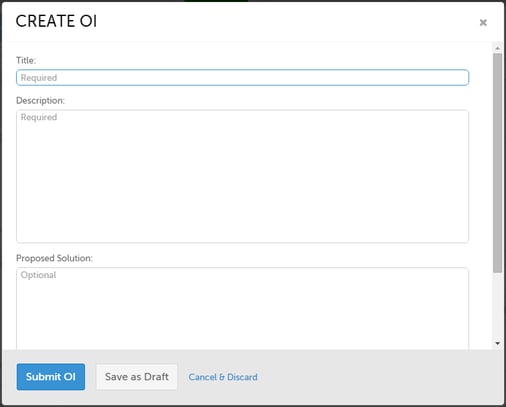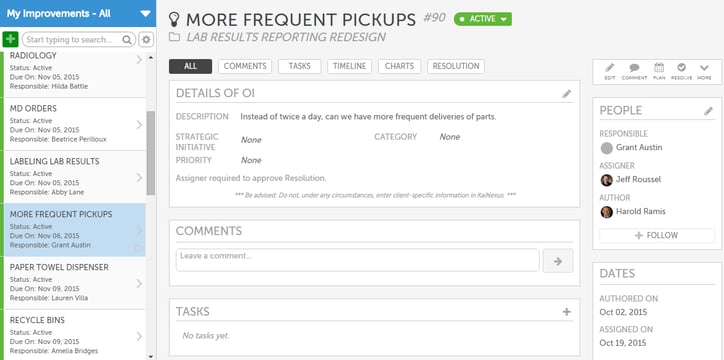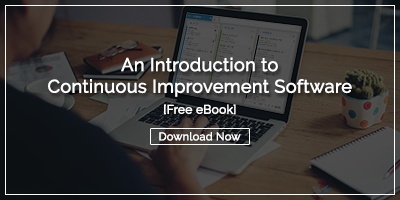 Shopping for technology can be frustrating. Vendors seem to toss around industry lingo and acronyms as if you understand their products as well as they do. We try not to do this to our customers and prospects, but I’m sure we’re guilty of it from time to time. We thought it might be helpful to give you a super quick guide to some of the terms you are likely to hear if you are evaluating continuous improvement software. Most of what we define will be true for any product you consider, but we’ll point it out when we mention something specific to the KaiNexus solution.
Shopping for technology can be frustrating. Vendors seem to toss around industry lingo and acronyms as if you understand their products as well as they do. We try not to do this to our customers and prospects, but I’m sure we’re guilty of it from time to time. We thought it might be helpful to give you a super quick guide to some of the terms you are likely to hear if you are evaluating continuous improvement software. Most of what we define will be true for any product you consider, but we’ll point it out when we mention something specific to the KaiNexus solution.
Business Process Methodology
A business process methodology is a structured approach to specific procedures that provides guidelines for how to approach different scenarios. Some of the more popular methodologies include Six Sigma, Lean, Total Quality Management, and the Toyota Production System. Continuous improvement software vendors talk about business process methodologies when describing whether their solution is designed for users of a specific one, or (as in the case of KaiNexus) flexible enough to be used with any.
Impact Calculation
The best improvement technology solutions include a method for measuring the results of improvement efforts. This is often called “Impact Calculation.” It is a technology feature that helps determine the effect of improvement on business objectives like cost reduction, quality improvement and revenue.

Improvement Broadcasting
Improvement broadcasting refers to the ability of a solution to notify all users when work on any particular improvement project has been completed. It is a method of celebrating success and recognizing the efforts of employees who contribute to positive change.
KPI (Key Performance Indicators)
These are the metrics that can be put into place for a company, department, or employee that help predict future success and identify potential roadblocks. Continuous improvement software allows you to use these indicators to target additional opportunities for improvement.
Mobility
When a continuous improvement software vendor talks about mobility, they are referring to the ability to use the solution on mobile devices such as smartphones or tablets. This is an important advantage because it makes it easy for employees to get involved in improvement wherever they happen to be. Mobility makes it possible to engage employees in the improvement process who don't have regular access to a computer at work.
OI (Opportunity for Improvement)
Opportunities for improvement can be found in any process, by an employee in your organization. Continuous improvement software makes it easy for employees to submit these opportunities (the first stage of the improvement cycle), and facilitates the opportunities' progression through the improvement cycle. KaiNexus allows you to customize the information required to submit an opportunity for improvement, making is as simple or as detailed as you need.

Repository
Just like your bank is a repository for cash, improvement technology serves as a repository for all the OIs and all the data that is associated with improvement work. Over time, the solution becomes the center for tribal knowledge. Everyone can see which improvement initiatives are in progress. They can also learn from past performance to better predict which approaches to improvement will get the greatest impact.

SaaS (Software as a Service)
SaaS is a software distribution model in which applications are hosted by a vendor or service provider and made available to customers over a network, typically the Internet. Applications that are said to be “Cloud-based” are usually delivered via SaaS. This approach makes implementation easier and puts the onus for software updates and maintenance on the vendor. It also generally means that the application will be available from anywhere.
Workflow
The dictionary defines workflow as, “An orchestrated and repeatable pattern of business activity enabled by the systematic organization of resources into processes that transform materials, provide services, or process information,” but you probably already knew that. In terms of continuous improvement software, workflow includes a series of alerts and notifications that help managers make sure that forward progress on active improvement projects is maintained.
These are the terms we are most often asked about by people who are looking for technology to support their improvement efforts. We’re sure there are others that aren’t immediately obvious to those who hear them. If there are more you’d like us to explore, just let us know.
For more information about continuous improvement software, check out this free eBook:



Add a Comment